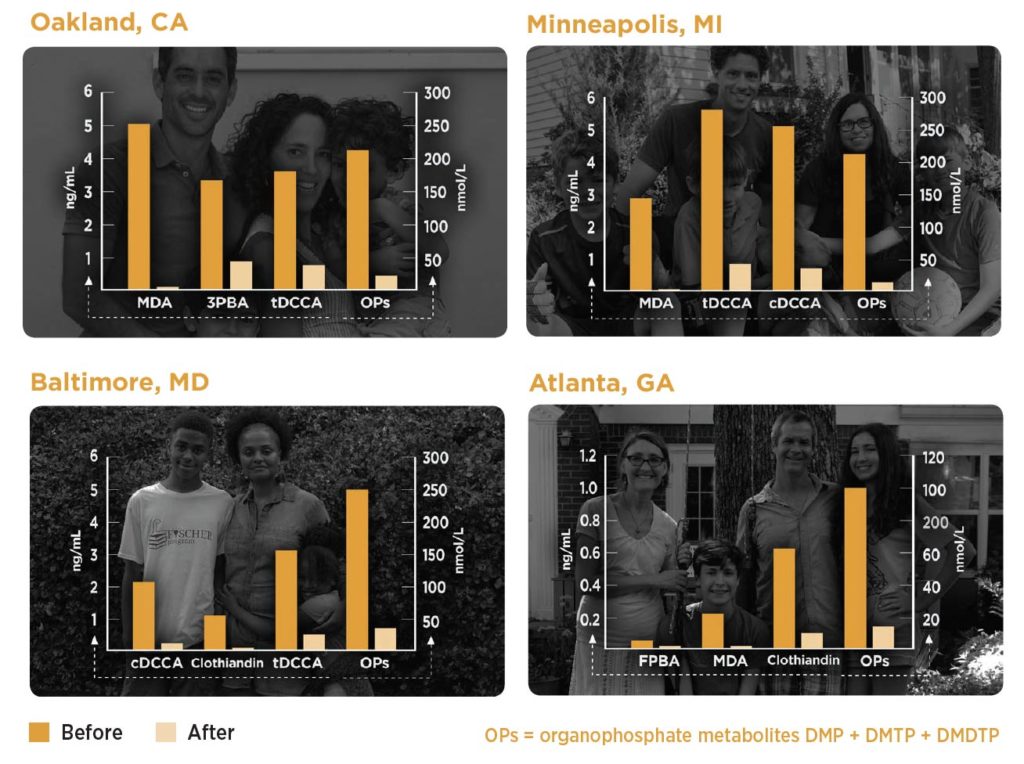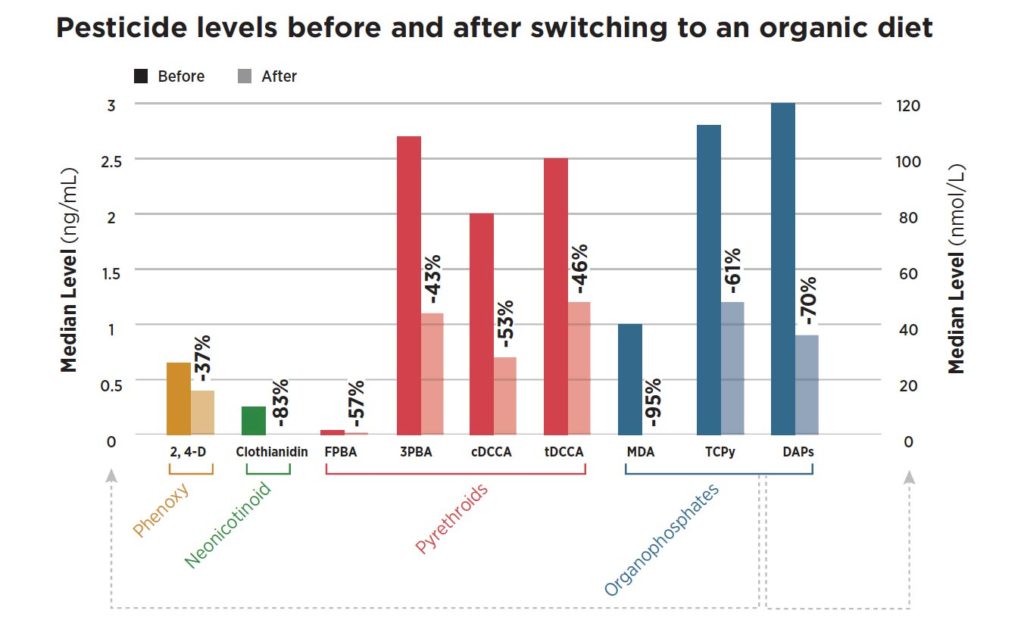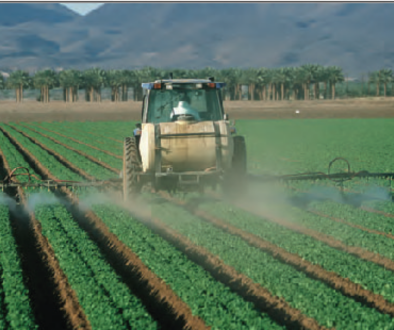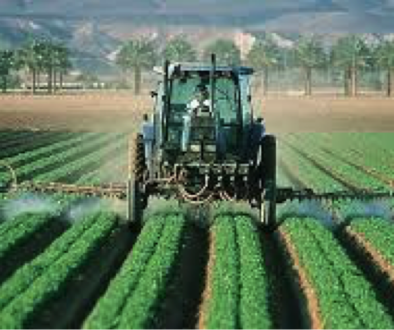Affordable Organic for All: Results Show How an Organic Diet Reduces Pesticides in Our Bodies

All of us are exposed to a cocktail of toxic synthetic pesticides linked to a range of health impacts in our daily diets. Certified organic food is produced without these pesticides. But can eating organic really reduce levels of pesticides in our bodies?
In this peer-reviewed study, we compared pesticide levels in the bodies of four American families for six days on a non-organic diet and six days on a completely organic diet. We found that eating organic works.
An organic diet rapidly and dramatically reduced exposure to pesticides in just six days.
Organic Works
We found 14 chemicals representing potential exposure to 40 different pesticides in every study participant, including organophosphates, pyrethroids, the neonicotinoid clothianidin and the phenoxy herbicide 2,4-D.
Levels of all detected chemicals dropped an average of 60.5 percent in just six days on an organic diet with a range of 37 percent to 95 percent depending on the compound.
The most significant drops occurred in a class of nerve agent pesticides called organophos- phates. The metabolites for malathion (MDA) and chlorpyrifos (TCPy) decreased 95 and 61 percent respectively, and a set of six metabolites representing organophosphates as a class (DAPs) dropped 70 percent. These pesticides are so harmful to children’s developing brains that scientists have called for a full ban.1 Chlorpyrifos is a neurotoxic pesticide linked to increased rates of autism, learning disabilities and reduced IQ in children and is also one of the pesticides most often linked to farm worker poisonings.2
The neonicotinoid pesticide clothianidin dropped by 83 percent. Neonicotinoids are among the most commonly detected pesticide residues in baby foods.3 They are associated with endocrine disruption and changes in behavior and attention, including an association with autism spectrum disorder.4,5 Neonicotinoids are also a main driver of massive pollinator and insect losses, leading scientist to warn of a ‘second silent spring’.6,7
Levels of pyrethroids were halved. Exposure to this class of pesticides is associated with endocrine disruption, adverse neurodevelopmental, immunological and reproductive effects, increased risk of Parkinson’s and sperm DNA damage.8,9,10,11
Finally, 2,4-D dropped by 37 percent. 2,4-D is one of two ingredients in the Vietnam War defoliant Agent Orange.12 It is among the top five most commonly used pesticides in the U.S.13 and is associated with endocrine disruption, thyroid disorders, increased risk of Parkinson’s and non-Hodgkin’s lymphoma, developmental and reproductive toxicity and damage to the liver, immune system and semen quality.14,15
We All Have the Right to a Toxic-Free Food System
The science is clear. Organic agriculture can produce enough food to feed a growing world population while protecting our health and the environment.16
We have the solution. And yet, our government subsidizes pesticide-intensive agriculture to the tune of billions of dollars while organic programs and research are woefully underfunded.17
Pesticide companies spend tens of millions of dollars lobbying legislators and funding false science and front groups that mislead the public about the harms of pesticides to keep their toxic products on the market.18
The top four pesticide manufacturers reap over $150 billion in profit each year.19 Meanwhile, the estimated environmental and health care costs of pesticide use in the U.S. is estimated to be upwards of $12 billion annually.19
We Should Not Have to “Shop Our Way Out” of Exposures to Toxic Pesticides
Elected officials must protect the health of people and the planet and stand up to corporate influence. And the food industry has a responsibility to consumers, the environment and society at large.
We all have the right to food that is free of toxic pesticides. The farmers and farmworkers who grow our nation’s food, and their communities, have a right to not be exposed day in and day out to chemicals linked to cancer, asthma, reproductive and developmental harm and other serious health problems. And the way we grow food should “Everyone has the right to clean organic food. That is a human right.” Tara, study participant, Baltimore protect rather than harm the ecosystems that sustain all life.
Together, We Can Make Organic For All
Together, we can demand government and corporations step up to create a healthier world for all people. We can work together to pass laws in our cities, states and nationally that decrease pesticide use and expand organic farming. We can change the national Farm Bill — a major piece of legislation that determines how food is grown in the U.S. and what food is available to us as eaters. And, we can tell food companies and grocery stores to end the use of toxic pesticides in their supply chains and expand organic offerings.
The solution is here — we just have to grow it.
Link to Study, Organic diet intervention significantly reduces urinary pesticide levels U.S. children and adults: https://www.sciencedirect.com/science/article/pii/S0013935119300246
SOURCES
1. Hertz-Picciotto, I., Sass, J. B., Engel, S., Bennett, D. H., Bradman, A., Eskenazi, B. and Whyatt, R. 2018. Organophosphate exposures during pregnancy and child neurodevelopment: Recommendations for essential policy reforms. PLoS medicine, 15(10), e1002671.
Pesticide Action Network. Chlorpyrifos. Online. http://www.panna.org/resources/chlorpyrifos-facts
2. Cimino, A.M., et al. 2017. Effects of Neonicotinoid Pesticide Exposure on Human Health: A Systematic Environ Health Perspectives. 125(2): p. 155-162.
3. Hoshi, N., Hirano, T., Omotehara, T., Tokumoto, J., Umemura, Y., Mantani, Y., Tanida, T., Warita, K., Tabuchi, Y., Yokoyama, T. and Kitagawa, H., 2014. Insight into the mechanism of reproductive dysfunction caused by neonicotinoid pesticides. Biological and Pharmaceutical Bulletin, 37(9), 1439-1443.
4. Science Daily. 2018. Neonicotinoids may alter estrogen production in humans. April 26. Online. https://www. com/releases/2018/04/180426125939.htm
5. Bijleveld van Lexmond, Maarten et al. 2015. Worldwide Integrated Assessment of the Impact of Systemic Pesticides on Biodiversity and Ecosystems. Environmental Science and Pollution Research. 2(1).
6. New York Times Editorial Board. 2017. Insect Armadeggon. New York Times. October 29. https://www.nytimes. com/2017/10/29/opinion/insect-armageddon-ecosystem-.html
7. Go, V., Garey, J., Wolff, M.S. and Pogo, B.G., 1999. Estrogenic potential of certain pyrethroid compounds in the MCF-7 human breast carcinoma cell line. Environmental health perspectives, 107(3), p.173.
8. Quiros-Alcala, L., S. Mehta, and B. Eskenazi, 2014. Pyrethroid Pesticide Exposure and Parental Report of Learning Disability and Attention Deficit/Hyperactivity Disorder in U.S. Children: NHANES 1999–2002. Environ Health Perspect.
9. Beyond Pesticides. Pesticides Trigger Parkinson’s Disease. O https://www.beyondpesticides.org/assets/ media/documents/gateway/health%20effects/parkinson%27s%20cited.pdf
10. Jurewicz, J., Radwan, M., Wielgomas, B., Sobala, W., Piskunowicz, M., Radwan, P., Bochenek, M. and Hanke, W., 2015. The effect of environmental exposure to pyrethroids and DNA damage in human sperm. Systems biology in reproductive medicine, 61(1), pp.37-43.
11. Beyond Pesticides. Chemical Watch Factsheet: 2,4-D. Onli https://www.beyondpesticides.org/assets/media/ documents/pesticides/factsheets/2-4-D.pdf
12. US Environmental Protection Agency. 2017. Pesticides Industry Sales and Usage: 2008 – 2012 Market Estimates. Online. https://www.epa.gov/sites/production/files/2017-01/documents/pesticides-industry-sales-usage-2016_0.pdf
13. Beyond Pesticides. Pesticides that Disrupt Endocrine System Still Unregulated by EPA. Online. https://www. org/assets/media/documents/gateway/health%20effects/endocrine%20cited.pdf
14. Beyond Pesticides. Chemical Watch Factsheet: 2,4-D. Onli https://www.beyondpesticides.org/assets/media/documents/pesticides/factsheets/2-4-D.pdf
15. Cook, Hamerschlag and Klein. 2016. Farming for the Future: Organic and Agroecological Solutions to Feed the Friends of the Earth. Online. https://foe.org/resources/farming-for-the-future-organic-and-agroecological- solutions-to-feed-the-world/
16. DeLonge, M.S., Miles, A. and Carlisle, L., 2016. Investing in the transition to sustainable agriculture. Environmental Science & Policy, 55, pp.266-273.
17. Hamerschalg, Lappe, and Malkan. 2015. Spinning Food: How Food Industry Front Groups and Covert Communications are Shaping the Story of Food. Friends of the Earth. Online. https://foe.org/resources/spinning- food-how-food-industry-front-groups-and-covert-communications-are-shaping-the-story-of-food/
18. Finck-Haynes, Tiffany and Christopher Cook. 2016. Buzz Kill: How the Pesticide Industry is Clipping the Wings of Bee Protection Efforts Across the U.S. Friends of the Earth. Online. https://foe.org/resources/buzz-kill-how-the- pesticide-industry-is-clipping-the-wings-of-bee-protection-efforts-across-the-u-s/
19. Pimentel, D., 2005. Environmental and economic costs of the application of pesticides primarily in the United Environment, development and sustainability, 7(2), pp.229-252.







